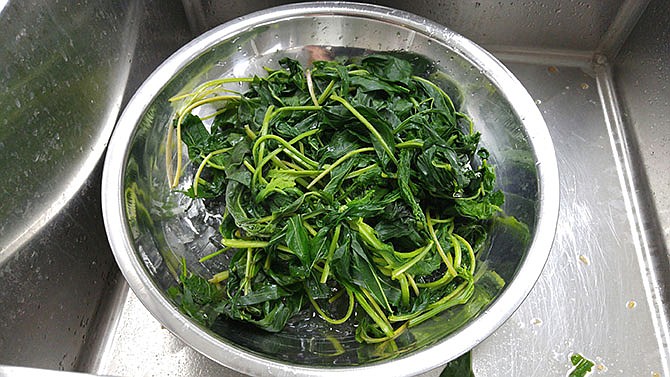You probably wouldn't guess that this plant is edible when you first glimpse it in the spring, but some of the earliest tasty greens of the year come from young cup plants.
It doesn't attract a lot of attention at first, with the leaves forming a basal rosette by March and April, with one to seven stems shooting up by late May. Cup plants not only offer greens for humans and forage for cattle, but the beautiful flowers are sought out by butterflies and other pollinators in the summer, and the seed is hunted by songbirds in the fall. Leaves for people can be harvested in April and May, blanched and used immediately in recipes or frozen for later use.
Ongoing studies at Lincoln University are evaluating the number of harvests per year when cup plants are maintained under partial shade. Early results showed that plants growing in the shade produce more tender leaves for longer periods, compared to plants grown under full sun. By mid-summer the leaves become fibrous with a very strong flavor.
The common name - and even the scientific name, Silphium perfoliatum - come from the fact that the leaves clasping around the stems form a cup where water gathers, offering an oasis for birds, insects and even small frogs during the hot summer months. Cup plant grows in a broad range of soils, from moist to dry and rich to poor. Once you learn to identify it, it is easy to spot. In the early rosette stage, it can be confused with the invasive teasel, except that cup plant does not have prickly spines.
This perennial plant is in the sunflower family and can grow up to 8 feet tall, but with proper pruning no later than mid-June it still blooms in the fall and the height is reduced by at least half. Cup plant can escape extreme cold conditions during dormancy in the winter and grow well during extreme warm weather in the summer. This resiliency makes it a good candidate for perennial gardens without requiring irrigation, fertilization or pesticides during these times of sudden weather changes. Cup plant is naturally found in wet prairies, forest openings, open fields and ditches, making it adaptable to grow under moderate shade or under full sun.
I first learned about the edibility of this plant from Sue Bartelette, native plant educator at Lincoln University. She learned about it from an elderly lady who took her and other young mothers a few years ago for gathering expeditions. Little is found in the literature, but a report by Kelly Kindscher, who wrote the book "Edible Wild Plants of the Prairie," suggests gathering the young leaves in the spring.
The seeds are also edible, but can be consumed rather quickly by songbirds in late summer and early fall.
An interesting note is that this plant has been introduced as forage in Chile, Russia and other European countries; a report in Chile claims it to be highly nutritious for cattle but not productive enough.
If you are interested in learning more about this plant and others featured in this column and want to try tasting them, plan to visit the Native Plants Program booth at the Lincoln University Farmers Market in downtown Jefferson City on Saturdays this May. The first 25 people to bring a copy of this article will get a door prize! Food samples and live plants will be available at reasonable prices, and there will be live plants on display of all the edible native plants that have been discussed in this column since January.
Also, if you want to help us evaluate some of the recipes we prepare with native edibles check our Facebook page, Lincoln University Native Plants Program, to reserve your spot.
2 pounds goat meat (or your choice of meat or tofu), cut into chunks
1 cup of cup plant, minced
4 tablespoons olive oil
2 sprigs of parsley, minced
2 sprigs of dittany (or oregano), minced
12 wild leeks (or 1 large onion), whole
2 tablespoons curry powder
2 cups of vegetable broth
2 large tomatoes, diced
Salt and pepper to taste
Season the meat or tofu with salt and pepper; let it sit for an hour. In a deep skillet, heat the oil. Braise the meat until browned. Add leeks and sauté until translucent. Add stock, spices, cup plant and curry; stir. Reduce heat to low and simmer for two hours in a covered pan. Add tomatoes and simmer for 30 minutes or until meat is done. Garnish with fresh parsley and serve with gooseberry sauce.

